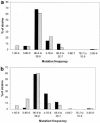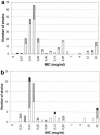Polymorphic mutation frequencies in Escherichia coli: emergence of weak mutators in clinical isolates
- PMID: 15292159
- PMCID: PMC490890
- DOI: 10.1128/JB.186.16.5538-5542.2004
Polymorphic mutation frequencies in Escherichia coli: emergence of weak mutators in clinical isolates
Abstract
Polymorphisms in the rifampin resistance mutation frequency (f) were studied in 696 Escherichia coli strains from Spain, Sweden, and Denmark. Of the 696 strains, 23% were weakly hypermutable (4 x 10(-8) < or = f < 4 x 10(-7)), and 0.7% were strongly hypermutable (f > or = 4 x 10(-7)). Weak mutators were apparently more frequent in southern Europe and in blood isolates (38%) than in urinary tract isolates (25%) and feces of healthy volunteers (11%).
Figures




References
-
- Cars, O., S. Molstad, and A. Melander. 2001. Variation in antibiotic use in the European Union. Lancet 357:1851-1853. - PubMed
-
- Chao, L., and E. C. Cox. 1983. Competition between high and low mutating strains of Escherichia coli. Evolution 37:125-134. - PubMed
-
- DeVisser, J. A. 2002. The fate of microbial mutators. Microbiology 148:1247-1252. - PubMed
Publication types
MeSH terms
Substances
LinkOut - more resources
Full Text Sources
Other Literature Sources
Medical

